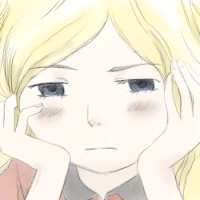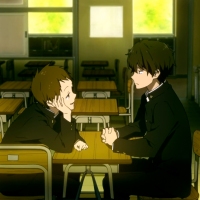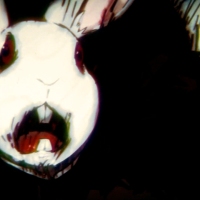ajthefourth: As mentioned last week, Little Busters introduces a different set-up scenario than previously-adapted Key works by having a main group of five pre-established friends. What this means for our hero, Riki Naoe, is that he’s not isolated due to a recent relocation (Yukito, Air, Yuichi, Kanon) or lacks friends due to his perceived delinquency (Tomoya, Clannad), which already makes him very different from his predecessors. What this means for our story is that there are existing relationships to build upon, ones that will contrast with the developing relationships that Riki is sure to establish with the to-be future haremettes, or baseball team members.
However, the most interesting study in Little Busters, both from a literal and construction standpoint, is the character of Rin Natsume. The fact that she has been included as a “member” from the get-go makes her unique, simply because of her gender. This is no watery childhood friendship, a promise to be lost to memory and the whispering wind, Rin is already well within Riki’s radar because she’s already his actual friend.
Seemingly, Rin is a refreshing breeze in a stagnant or bygone genre. Or she would be, if her characterization was steadier. In the company of her friends, all male, she is confident and assertive; however, as soon as another female character, Komari, is introduced to the mix, she becomes an awkward, stuttering mess. The same girl that kicks Misato upside the head and orders the group into helping her clear out the storage shed cowers behind weak-looking Riki for fear of a be-ribboned girl with cat mittens. This reduction is more frustrating to watch than Komari’s introduction, which my blogging partner will touch upon in a bit, because it lowers Rin to the level of the budding friendships that Riki is beginning to acquire. In spite of her introduction as one of the group, the viewer, and Riki, must be reminded that she is also an option, another route.
This idea is reflected within Episode Two as a whole. The series is at its most genuine when it focuses on the established group dynamic, and at its weakest when Riki is off meeting potential additions to the team. Speaking of that…
otou-san: Let’s talk about infantilization for a second.
I don’t want this to turn into a “you can’t condemn rapey-ness in a shoujo anime unless you’re prepared to condemn the genre as a whole.” Mostly because I am prepared to lay judgment down on all of anime, but especially on the mighty Maeda. Perhaps it’s not measurably worse than comparing the moe equivalent of Rain Man to a stupid cat, but with Key it’s… somehow institutional.
Gao, you say.
Uguu, you shout, as if to say “but if it works, it’s ok, right?”
Starfish dozo?? you plead as you desperately try to inject your idealist-romantic’s tears straight into my ducts.
Far from the manzai-team abuse of Chuunibyou’s lead pair, infantilization of female characters in anime (probably the biggest gripe that mainstream audiences have with moe in general) manifests as a mix of physical abuse and tenderness, with a healthy side of psychological patronizing. In the world of Key, where a lead character is always a helpful gentleman and the haremette is basically a solvable problem with hair, it always feels pretty prevalent to me. Even powerful Tomoyo had the emotional maturity of a newborn gym sock and Kyou’s assertiveness was a mask for a garden-variety tsundere schoolgirl crush.
And then there’s Anteater Panties. Here, Maeda has obviously mastered the art of subtlety because she not only lacks a kawaii catchphrase, she wears her metaphorical taco-stegosaur on her drawers instead of her shirt. I think you’ll agree that we’ve reached a new level of nuance.
As for Rin… I’m sure in the end it’s going to be a hackneyed, worn-out something in her backstory that makes her so shy, and eventually she’ll be a good friend to all the girls. But while (being a girl, and thus a route) she’s probably the most obvious of the core group, at least I can see a story in there. Too often — and here I’m thinking e.g. the Mamiko Noto girl in Clannad — the “depth” is tacked on like an off-painted spoiler on a Ford Escort, but here the effort is made to create interest early on. Interest in what, though?
Tragedy, no doubt. Beautiful, barely-orchestrated tragedy — the kind that wakes Maeda from his endless repose and wracks his body with spasms of pleasure. It’s only episode 2, so the great beast still slumbers, but when the tears of a few thousand virgins reach him… god help us all.














“And then there’s Anteater Panties.”
Best segue I’ve ever seen.
Matched by this pretty artful use of sarcasm:
“I think you’ll agree that we’ve reached a new level of nuance.”
Personally I was entranced by the double entendre of the taco-stegosaur.
otou-san’s scathing analysis warms the cockles of my heart. As someone who helped a friend install a sunroof in a Ford Festiva (because he lacked the means to otherwise mod it), I’m feeling you, bro.
I don’t think you understand how badly I want to hear the rest of that story…
Please tell me this involved gratuitous and inadvisable uses of a powered hacksaw.
Actually it was just a plain old hacksaw (which made overcoming the inherent cutting depth issue rather entertaining as it necessitated about 5x as much cutting as was really warranted). Two guys, one hacksaw, one mysterious hole (in the ROOF), one girl that they were both in love with, and one blazing hot day in San Diego. Good times. Except for the part where my car overheated on I-5 at 3 AM later on, that sucked.
This should be a movie.
as someone who’s never self-installed a sunroof in a Fiesta, I wish I could say that I feel you back. I did manually parallel park a Dodge Omni with two other people though.
Did you consider cutting the top all the way off and seeing how far you could get before the thing folded up like an accordion?
Well, he would have tacked on an inappropriate and off-painted spoiler if there had been a place to put one. And if he had a drill. Or a hammer and a screwdriver. We never really got into the subtleties of how he happened to have a hacksaw but no other tools whatsoever. And you know, it would have taken far less time to lop the top off, but we never considered that. By the end of the day we did think about setting the whole thing on fire though.
Ok, I’ll step up and sorta-kinda defend the show from the perspective of someone who hasn’t played the game but generally likes Key stuff and whatever.
I think its kinda interesting that Rin’s fully confident and assertive around her male friends, but goes all to pieces whenever another female (even one as obviously harmless as Komari) shows up. Considering that we’re about to get inundated by females, I’d think that that will end up being a major thing.
Or it could not be, but I’d assume it is, from how they beat us over the head with it.
I am also someone who has not played the game but generally likes Key stuff. ^ ^
Regarding Rin’s lack of an ability to communicate, I don’t find it interesting but annoying, mainly because I think that there were better ways to show it than having her unnecessarily go to pieces every time Komari comes near her. In fact, they used these better ways in the first episode, when Rin was attempting to recruit in the girls’ dormitory. Sure, those conversations were awkward, but she didn’t hide from people or fall to pieces as she does in episode two. She even ends up getting into a fight with the softball queen. So then, for what purpose does she suddenly lose all ability to speak around Komari in episode two? Did we really need to be reminded that she too, is helpless? Perhaps I’m a bit off-base here, but it reeks of reducing her character to an easily-definable trait because she too, is another route.
Don’t get me wrong, Rin is one of my favorites in the series thus far, which is probably why this bothered me so.
I find it interesting too — if only in the sense that, like I said, there’s a hint of forethought to her storyline. I’m hoping that’ll lend a little more cred to whatever happens down the road when this is expounded upon.
I do agree with ajthefourth though that it’s ham-fistedly executed at times, but then again, what isn’t here?
> Mostly because I am prepared to lay judgment down on all of anime, but especially on the mighty Maeda.
Not to be a Key apologist, but it’s worth noting that only the four childhood friends were written by Maeda. The rest of the characters were handled by other Key writers. This manifests itself as an inconsistency of tone in the original VA, and in my opinion is especially grating in the case of Komari.
He’s sort of a proxy target, and it’s easy to interchange the two flippantly, for which I apologize. I find it hard to believe that the key team doesn’t influence each other as they go, but if there’s inconsistency in the tone that seems like a flawed process/product. I’d be curious about what you think as this goes along — you’ll have to report back to us on whether the anime has unified the story a little more.
The funny thing about these posts is that this show hasn’t developed enough personality for its fans to defend itself from Dad’s criticisms. This is like the unplanned 5th brother. It has all the markings of the family, but all the critiques so far are hand-me-downs. Eventually it’ll hit it’s teens and it won’t want Clannad’s dirty comparisons anymore. You’re in for it then, Dad.
Well, maybe when it turns 18 episodes, we can talk about it then.
That last paragraph is pure poetry.
I wasn’t so bothered by the idea of Rin’s difficulties with other girls so much as I was turned off by its execution. From a story standpoint it makes sense. She’s been friends with four guys since childhood which makes it reasonable for her character to be awkward around other girls. Plus, we are informed that Rin is popular among the boys which no doubt puts her at odds with the other ladies in school. Rin’s situation with her female classmates might have been an interesting aspect of her character to explore if it was done with some care. Unfortunately, she was rendered cowering and helpless in what I can only assume is an attempt to make her more moe.
As for the introduction of Komari…. I think I lost a good number of brain cells watching this episode because of her. I just don’t get what the appeal is of a character acting like she’s five years old. ^ ^;
Oh definitely. It makes sense and, as I said above in a previous comment, it was portrayed better in the first episode with girls in her dorm and softball ojou-sama. Her awkwardness, stutter, and inability to hold a complete conversation were all done well. In addition, when faced with a scenario where she can’t communicate properly, she eventually resorts to violence, a reflection on rough-housing with a group of four guys growing up (well, three guys, Riki doesn’t seem like much of a rough-houser ^ ^). I wish they had continued this since it makes more sense for her character than cowering.
Yeah…I think I got dumber watching Komari, too. She makes me want to scream.
I think there’s a blurry line between “adolescent who is immature and not so smart” (Ayu Tsukimiya) and “adolescent with experiences of a teenager but mind of a 5-year-old” (Komari). It’s a little uncomfortable to watch her…but when I think of her as a possible path (the same would go for Fuuko if I had approached Clannad with it’s source material in mind), I really feel like watching something else instead.
I won’t spoil it but, her arc/path explains why she acts like a five year old. Lets say when I first met her I wanted to stab myself and throw the computer out the window. Surprisingly, her arc is the most normal and probably one of the better written imo.
“… a promise to be lost to memory and the whispering wind …”
That’s One interesting example you’ve got there. ;D
Anyway, don’t have much to say that others already haven’t, except we need more fake Bert and Ernie. Everything needs more not Muppets.
Not Muppets were the best characters in this episode. ^ ^
Also, One~ will always be remembered as “that nonsensical boring Key anime that gave me a stye in my eye.”
Komari’s infantilization also surprised me. In the VN she was more like the kind of person who goes at her own pace, but it seems they decided to play her moe up in the anime. And I think they translated Rin’s overall crippling shyness poorly, too. Again, in the VN she was just painfully shy and awkward around everyone else that wasn’t the four boys, instead of scared, which is an important part of her character development.
And that gets me to Riki. Although I like Yui Horie’s work, in the original his voice was more femenine because he’s supposed to be something like the seventh heroine. Or so do some of us VN readers think.
She definitely could have been portrayed better. For example, Ayu (Kanon) was a bit dumb but tolerable, even with her “Uguu” catchphrase. Listening to Komari talk about how sweets are lovely because…they’re happy, or something, made me want to bash my head against the wall.
I’m still liking Rin the best. It’s nice to know that she was given a fairer shake in the VN in terms of characterization. As I said previously, I liked the way her shyness was portrayed in the first episode, but it was horribly disconnected and nonsensical in the second.
That’s an interesting point you make about Riki, and one that I’ll keep in mind while watching. Thank you.
About Rin again, keep in mind too she’s not just another heroine like Komari, but the other main character along Riki. Her route in the VN is pretty unconventional. And that’s all I can say without spoiling the whole story.
Not to get off the subject of Little Busters, but has your team thought of tackling Shinsekai Yori this season? Four episodes in and it’s a cornucopia of psychological and societal brainwashing all rolled up into an interesting ball of progressive evolution. I’d love to see your thoughts on this show as it’s shaping out to be the best series of the season (as far as I can see).
Just thought I’d ask anyway since I’ve always enjoyed your thoughts/deconstruction of series like Penguindrum and Shinsekai Yori comes pretty close to Penguindrum in terms of hidden meanings/clues/psychology.
Hello! I didn’t want to respond until I had seen the fourth episode myself. Both David and I have been watching Shin Sekai Yori together and have enjoyed it immensely. Since it was a slow burn of a series until the most recent episode, we didn’t have much to say about it episodically. We do have a great deal to say about it following this most recent episode, and are waiting on a few things to hopefully be revealed in the fifth episode that will tie in to our current thoughts.
Thanks for the request. ^ ^
This adaptation isn’t very good is it? I don’t know if you saw the latest episode yet, but the editing is pretty horrible. I can see what they’re trying to do, but it’s so cut-and-paste that what they’re doing is losing impact badly.
Pingback: Colloquium: Little Busters! Episodes Four and Five | The Untold Story of Altair & Vega